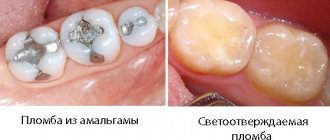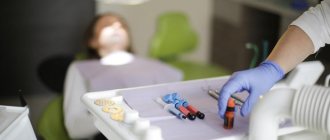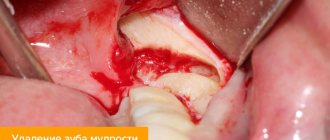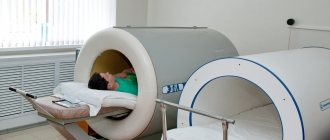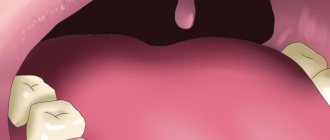After a visit to the dentist, it seems that the problems are over. But often the unpleasant sensations persist for some time. Why does a tooth hurt after treatment, and what to do in such a situation? The reasons often depend on what kind of manipulation the dentist performed. Features of treatment, in turn, are determined by the specifics of the disease. The more serious the dentist’s actions, the higher the likelihood that tooth pain will continue to bother you even after a visit to the doctor. It is important to listen to your feelings so as not to miss alarming symptoms.
Why does a tooth hurt after filling?
Treatment at the dentist, it would seem, is the surest way to say goodbye to toothache. But very often pain syndrome haunts patients even after visiting the dentist. The most obvious reason is the body’s reaction to the drilling machine. After all, the process of removing infected and already dead parts of dental tissue is a kind of operation, and therefore an injury. It is not surprising that in response to this, the nerve endings “sound the alarm.”
In this article we will talk about when pain after dental treatment is an acceptable norm, and in which cases it is a pathology that is dangerous to health if ignored.
Why do teeth hurt after filling?
After filling and/or removal of the affected pulp (the tissue that fills the tooth cavity), teeth may hurt for two main reasons. The first is the physiological reactions of the body to drilling and installation of a filling. The second is human factors (errors or negligence of the dentist).
The most common cases
- Hypodiagnosis of pulpitis. We are talking about an incorrect diagnosis when the doctor mistakes chronic pulpitis for deep caries. The filling is placed on untreated canals, which is why the pain does not go away after tooth treatment.
- Depressurization of the seal. Most often it happens from installing a filling in an under-dried tooth cavity. The composite material comes off from the bottom of the cavity, irritating the nerve endings. Depressurization can also be caused by mechanical damage to the seal.
- The negative impact of dental polymerizers (lamps that are shined on a filling to harden it). As the material hardens, the filling shrinks. A tightly attached filling puts pressure on the walls of the tooth, which can cause a crack to appear in the crown. Air enters the cavity, the nerve endings react. Also, some dentists believe that the heat emitted by polymerizers affects the pulp and changes its structure, which causes pain.
- Overdrying of dentin. The tooth cavity in which the filling will be installed must have a certain humidity. When overdrying, the nerve endings in the surface layer of dentin become irritated and make themselves felt.
- Change in bite. When installing a filling that is too high, it begins to interfere, which leads to pain when biting.
- Allergic reaction. An allergy can be to both materials and medications used during treatment. It is not difficult to recognize such a reaction: patients have severe tooth pain after filling, gums swell and hurt. If you are allergic to painkillers, you may experience a headache.
Medical errors and negligence:
- root perforation (tissue damage in the form of a through hole);
- removal of the filling material beyond the root (severe cases, after which the pain syndrome can last up to six months);
- improperly sealed canal (not fully processed, not filled enough);
- breakage of the instrument in the canal (in difficult cases, the fragments are removed surgically).
How to treat swollen gums, how to relieve swelling
Before taking any action, you need to determine the cause of the swelling (edema). This is important, since treatment tactics will be different in each case and those actions that are necessary in some cases may cause a worsening of the condition in others.
Exacerbation of periodontitis
Symptoms
Periodontitis is an inflammatory process in the bone associated with infection entering the root canals of the tooth and its further spread into the bone. In conditions of decreased immunity (against the background of acute respiratory infections, seasonal cold snaps, severe general diseases), inflammation in the bones can go from chronic to the acute stage, which is accompanied by an increase in the amount of pus. As a result, pain and swelling appear on the gums. Periodontitis can occur either in a previously untreated tooth or in an already treated tooth with filled canals (if the canals have not been cleaned somewhere or additional canals have not been found).
With an exacerbation of chronic periodontitis, the following symptoms may occur (not necessarily all, there may only be some from the list):
- swelling of the gums in the area of the causative tooth;
- The swelling is small at first, but it increases over time, the mucous membrane becomes more “tense”, after a while a fistula may appear - a white bubble against the background of swelling. The fistula opens over time, pus flows out, and the swelling gradually decreases;
- pain when pressing on the gum with a finger and/or when biting on a tooth;
- the causative tooth does not respond to cold, warmth, or sweets;
- a carious cavity in the tooth (or, if the tooth has been previously treated, a large filling);
- possible increase in body temperature.
Pain and swelling with periodontitis appear due to the accumulation of pus, as soon as the pus is released (through the fistula - if without treatment, or through the root canals - if the patient went to the dentist), the pain goes away.
If the fistula has opened, the swelling has gone away, and there is no more pain, this does not mean that the problem is solved. There is still an inflammatory process in the bone and you need to see a dentist.
How is periodontitis treated in the acute stage?
It is necessary to consult a doctor to clarify the diagnosis. The dentist will take an x-ray to determine the location of the inflammatory process and its size. In the future (depending on the location of the process and its size), the doctor can offer three options for further action:
- Conservative treatment is dental treatment that creates an outflow of pus through the root canals, followed by filling.
- Surgical treatment – tooth extraction and cleaning of the socket.
- Combined treatment (if there is already a large tumor, but the tooth is planned to be saved) - the tooth is treated and an antiseptic is applied under a temporary filling, and at the same visit a loosening incision is made through which the pus will come out.
Which method will be used and in what case is decided by the dentist. The treatment method depends on the location and size of the process, the condition of the tooth, further possible prospects for tooth restoration, general health and many other factors.
In parallel with each of these interventions, procedures that need to be carried out at home can be prescribed:
- rinsing with a soda-salt solution (1 teaspoon of soda and salt per glass of water);
- taking antibiotics (most often lincomycin 0.5 grams 3 times a day – 5-7 days);
- anti-inflammatory drugs (most often nimesil - 1 packet 2 times a day for 3 days).
What to do before the patient can see the dentist?
- Do not warm the swelling area under any circumstances (do not apply heat, do not apply anything);
- soda-salt rinses (the more often the better - about 10 times a day);
- anti-inflammatory drugs (nimesil);
- You should not start taking antibiotics without a doctor’s prescription - you may end up with a blurred picture of the process and the doctor will not be able to decide on the correct treatment tactics in this case;
- Painkillers and anti-inflammatory drugs should not be mixed. If you have chosen one drug, then you do not need to take others at the same time - this can be dangerous to health and even life.
Acute gingivitis, exacerbation of periodontitis (gingivitis)
Causes
Gingivitis is inflammation of the gums, periodontitis is inflammation of the gums involving bone tissue. These processes occur only in the tissues surrounding the tooth, without affecting it. With gingivitis and periodontitis, the teeth themselves usually do not bother (except in cases of parallel progression of gum disease and dental disease). There are many causes of gingivitis (most often it is tartar, untreated carious cavities, incorrectly installed fillings and orthopedic structures, and bite characteristics). Gingivitis can be acute or worsened chronic; periodontitis most often has a chronic course with periods of exacerbations. Exacerbation may occur due to the following factors:
- injury to the gums with sharp objects (cuts, punctures with fish bones)
- foreign bodies in periodontal pockets (chipped tartar, bones, fibrous food)
- acute respiratory infections, acute respiratory viral infections, other systemic diseases,
- frequent exacerbations of gingivitis in diabetes, diseases associated with decreased immunity,
- taking drugs that reduce immunity (corticosteroids and others).
Symptoms
With gingivitis in the acute stage, the following are observed:
- pain and swelling of the gums near a group of teeth (localized gingivitis) or the entire jaw (generalized gingivitis);
- pain when brushing teeth and eating;
- bleeding gums at the slightest impact (brushing teeth, eating hard foods);
- the gums are red, sometimes bluish;
- possible reaction to hot food;
- pain when pressing on the gum;
- the teeth are partially covered by swollen gums.
With periodontitis, these symptoms are similar and the difference will be that with gingivitis there are no radiological changes in the bone, but with periodontitis there will be a decrease in the height of the interdental septa and their pattern is not clear. Also, with periodontitis, exposure of the roots of the teeth is observed, but in the acute stage, due to edema, the roots can be covered with soft tissue.
Treatment
Gingivitis and periodontitis also need to be treated by a dentist.
The following events are held in the office:
- removal of hard and soft dental plaque (possibly using anesthesia), polishing the surface of the teeth and exposed roots;
- correction of fillings, removal of traumatic elements of orthopedic structures;
- removal of foreign bodies, if any are found;
- treatment of the oral cavity with antiseptic solutions;
- applying anti-inflammatory drugs under the bandage;
- in severe cases, patch surgery may be required - exfoliation of gum tissue, cleaning of teeth, roots, bone from stone and affected tissue, followed by suturing.
In combination with this, antibiotics, anti-inflammatory drugs, painkillers, and antiseptic rinses can be prescribed.
Before you have the opportunity to visit the dentist, you can take the following measures:
- rinsing with a soda-salt solution (1 teaspoon of soda and salt per glass of water) and antiseptic solutions (chlorhexidine, furatsilin - according to the instructions);
- Be sure to brush your teeth. They use anti-inflammatory pastes and pastes to relieve bleeding gums (Paradontax, Lakalut Active, Thebodont and others), it is advisable to use thread;
- treating the gums with anti-inflammatory drugs (the most famous is Metragil Denta) 3 times a day, after brushing the teeth and rinsing;
- if it hurts to brush your teeth, you can treat the gums with an anesthetic before brushing (Dentol and other products used in babies when teething).
If after 2-3 days there is no improvement, then you need to consult a doctor, since gingivitis can become chronic or the situation may worsen - the formation of an abscess.
Periodontal abscess
An abscess is a localized area of inflammation characterized by the accumulation of pus under the gum. In fact, this is a cavity filled with pus, which looks like a hemispherical formation on the gum. The size of an abscess can reach the size of a walnut.
Causes
The causes of periodontal abscess can be different, but the most common are:
- release of pus from chronic periodontitis in the acute stage;
- accumulation of pus due to periodontitis;
- deep trauma with a foreign object, in which the infection entered deep into the tissue (an injection with a fish bone, in which a piece of bone remained in the gum, for example).
Symptoms
- A convex semicircular formation in the gum;
- when pressing, pain, elastic tense tissues, a symptom of fluctuation (when pressing on the formation, the movement of fluid inside is felt);
- swelling of surrounding tissues;
- swelling may spread to the cheeks, causing facial asymmetry;
- possible increase in body temperature.
Treatment
Treatment of an abscess in Samara depends on the cause of its appearance. If it develops as a result of injury (as in the case of a bone), then the treatment is exclusively surgical - opening the abscess, removing purulent contents, installing drainage. If the cause is periodontitis or periodontitis, then measures are taken in parallel to treat the causative disease.
After surgery, antibiotics, painkillers, anti-inflammatory, antihistamines are prescribed, and after 3-4 days, when the swelling subsides and the drainage is removed, epithelializing drugs are also prescribed. This treatment is prescribed by a doctor.
Need to know:
- If you notice symptoms similar to an abscess, you should immediately go to the doctor. Delaying treatment can lead to the formation of phlegmon - diffuse inflammation, which usually ends with cuts on the outside of the face, and can also lead to sepsis - blood poisoning.
- Inflammatory processes should not be heated. When heated, microorganisms multiply more actively, and this can also lead to rapid progression of the process.
Is it possible to get rid of pain using traditional methods?
Our answer is unlikely. If the reason is serious, then the pain will not go away on its own. In case of severe and prolonged pain, it is better to consult a dentist, who can suggest the true cause based on the symptoms. If this is just a reaction to medications, then physical therapy, for example, DDT (diadynamic therapy) and SMT (amplipulse), is effective in relieving pain.
But if you do not have the opportunity to urgently consult a doctor, then to relieve post-procedure pain, you can temporarily resort to traditional medicine methods:
- rinsing with decoctions of medicinal herbs (propolis, chamomile, celandine, oak bark, sage, yarrow);
- adding beets crushed to a porridge state;
- fir oil compresses;
- trigeminal nerve massage.
The tips described in the article will help relieve mild post-filling pain at home. In case of severe pathological pain and suspicion of complications, we recommend that you immediately consult a dentist. Our website provides a complete list of clinics where you can get qualified help.
10.10.2017
First aid for inflammation
It is better to use any medications to combat pathological symptoms after consulting a doctor, since all medications in this group have different compositions and a list of contraindications. At home, you can use various rinses as first aid before going to the dental clinic. They are not recommended for use for more than two days, since the absence of qualified assistance for a long period of time can worsen the patient’s condition and lead to the progression of the pathology.
Calendula decoction with salt
Calendula is one of the most famous medicinal plants. Calendula flowers (marigolds) have a disinfectant, antimicrobial and healing effect, so a decoction of this plant helps to quickly cope with inflammation and speed up the healing of soft tissues. If you add salt to the decoction, you can improve the condition of the gums during purulent inflammation, since any salt perfectly draws out pus and ensures the outflow of exudate.
To prepare a medicine to treat inflammation, you must:
- Pour 100 g of calendula flowers into 700 ml of boiling water and put on low heat;
- cook for 15-20 minutes;
- add a tablespoon of salt and cook for another 5 minutes;
- leave for an hour and strain.
You should rinse your mouth with this decoction 3 to 10 times a day (depending on the degree of inflammation). Symptoms usually become less noticeable on the second day of use.
Bread crumb infusion
If you don’t have medicinal plants at hand, you can use a very simple but effective recipe and prepare an infusion from bread pulp. You can use any type of bread made from rye or peeled flour, as they contain a large amount of minerals and vitamins that have a positive effect on the condition and health of the gums.
Preparing the infusion is very simple:
- break one piece of bread (approximately 50-70 g) into small pieces and place in a shallow container;
- pour 300 ml of boiling water and add half a spoon of salt;
- leave for 5-7 minutes and cool.
You should rinse your mouth with this infusion 3-5 times a day. The product perfectly helps with any inflammatory processes, pain after treatment and tooth extraction, as well as at the initial stage of purulent-infectious processes.


